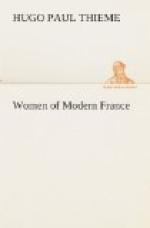The third mistress, Henriette de Balzac d’Entragues, Marquise de Verneuil, who led Henry IV. along a path of the worst debauchery, gained control over him by lewd, lascivious methods. While negotiations were being carried on for his divorce from Marguerite, only a few weeks after the death of Gabrielle, he signed a promise to marry Henriette; this, however, he failed to keep. She, more than any other of his mistresses, was the cause of national distress and of more than one ruinous war. When, after the marriage of the king to Marie de’ Medici, Henriette began to nag, rail, intrigue, and conspire, she was disgraced by Henry, who at least had the courage to honor his own family above that of his mistresses. She is accused of having had, solely from motives of revenge, a hand in the death of the king.
Thus, around the queens-regent and the mistresses of the kings of France in the sixteenth century there is constant intriguing, murder, assassination, immorality, and debauchery, jealousy and revenge, marriage and divorce, honor and disgrace, despotism and final repentance and misery. The greatest and lowest of these women was Catherine de’ Medici; Diana of Poitiers was famed as the most marvellously beautiful woman in France, and she was the most powerful and intelligent mistress until the time of Mme. de Pompadour. Amid all this bribery and corruption, elegant and refined immorality, there are some few types that represent education, family life, purity, and culture.
Chapter II
Woman in Family Life, Education, and Letters
The queens of France exerted little or no influence upon the cultural or political development of that country. Frequently of foreign extraction and reared in the strict religious discipline of Catholicism, they spent their time in attending masses, aiding the poor and, with the little money allowed them, erecting hospitals and other institutions for the weak and needy. Thus, they are, as a rule, types of gentleness, virtue, piety, and self-sacrifice.
The little information which history gives concerning them is confined mainly to their matrimonial alliances. To them, marriage represented nothing more than a contract—a union entered into for the purpose of settling some political negotiation; thus they were often cast upon strange and unfriendly soil where intrigues and jealousy immediately affected them.




